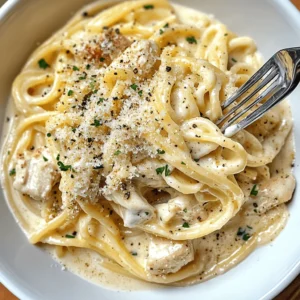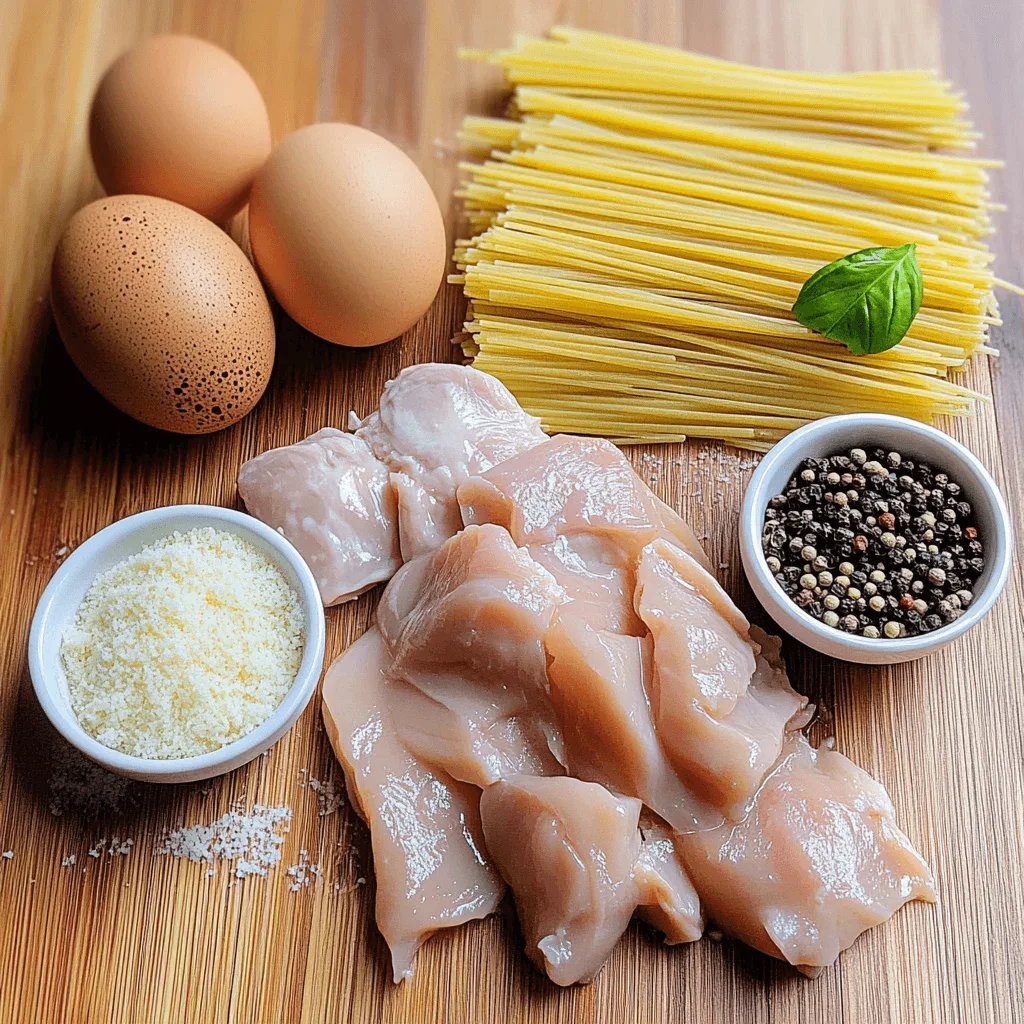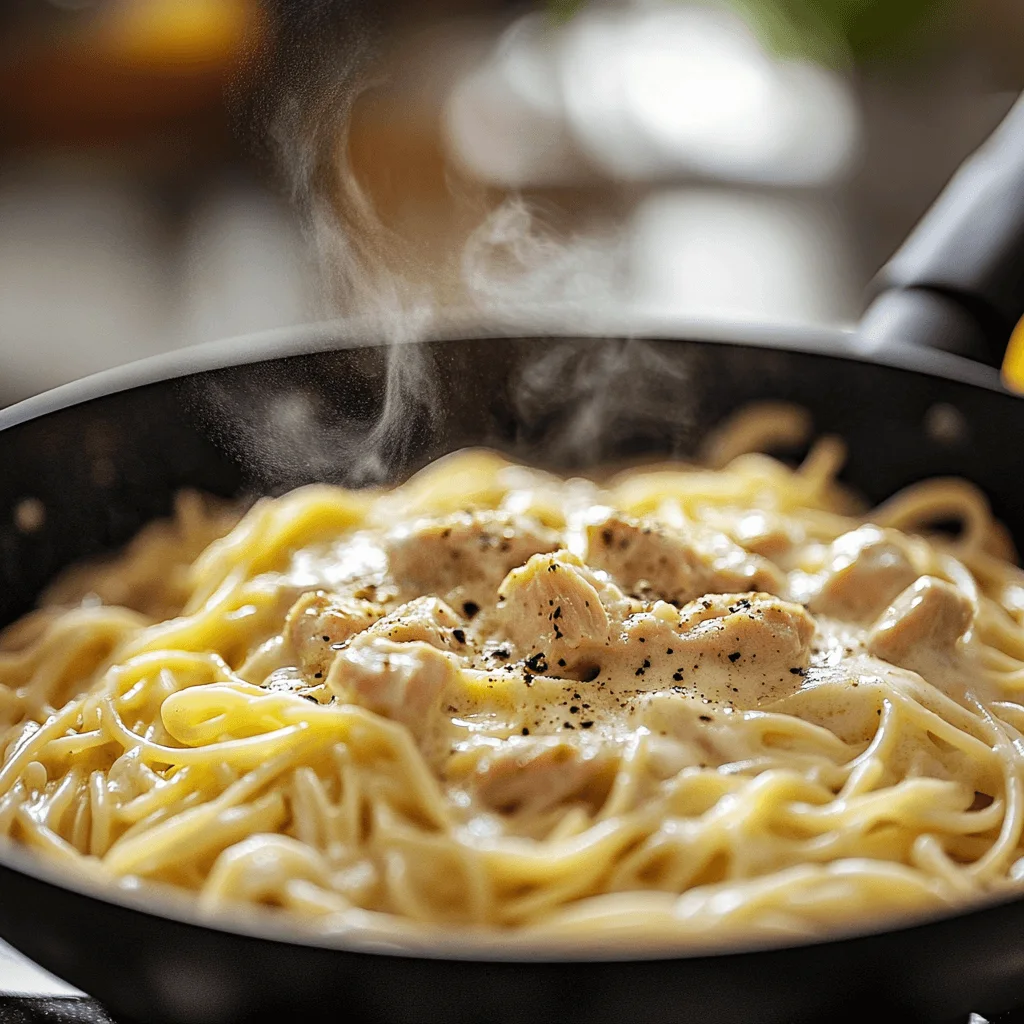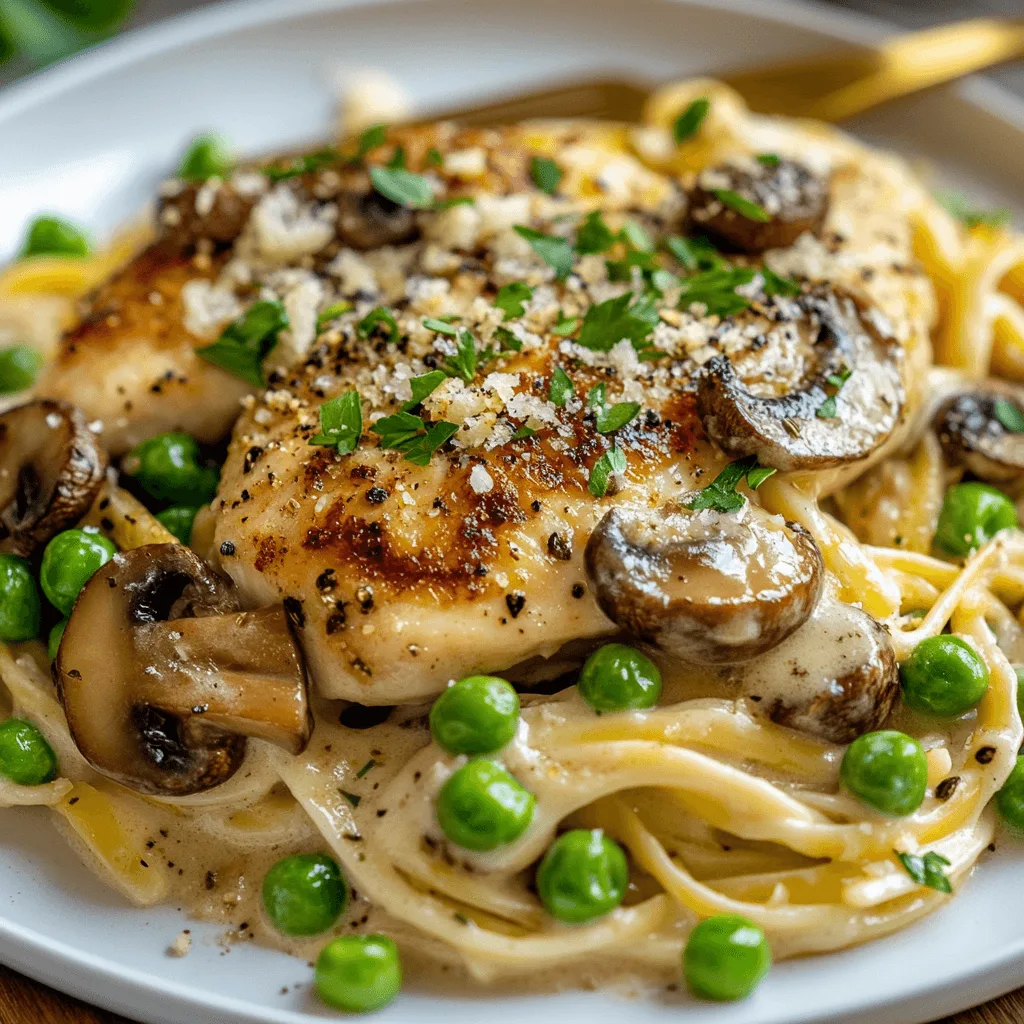When comfort meets creamy in one dish, the result is often a plate of chicken carbonara—a pasta lover’s dream. This chicken carbonara recipe blends rich flavor with simple techniques, making it perfect for both quick weeknight meals and impressive weekend dinners. With tender chicken, savory cheese, and silky sauce made the traditional Italian way, you don’t need cream to make this dish unforgettable.

In this guide, you’ll discover the best ingredients to use, how to cook everything just right, and even expert tips to avoid common mistakes. By the end, you’ll be confident enough to make a chicken carbonara recipe that tastes like it came from your favorite Italian bistro.
Table of Contents
Introduction to Chicken Carbonara Recipe
What is Chicken Carbonara?
At its core, chicken carbonara is a flavorful upgrade of the Italian classic. Traditional carbonara typically features pasta, egg yolks, Pecorino Romano, and cured pork. In this version, seasoned chicken takes the spotlight. The swap gives this chicken carbonara recipe more protein and a comforting, meaty texture—without straying far from the dish’s roots.
This is not your average cream-based pasta. In fact, no cream is used at all. The creamy consistency comes from a simple emulsion of egg, cheese, and hot pasta water. It’s indulgent, yes, but not heavy. And with the addition of chicken, it becomes a complete, satisfying meal that’s ready in under 30 minutes.
How Chicken Carbonara Became a Modern Favorite
While traditional carbonara has been around for generations, the chicken carbonara recipe gained popularity in American kitchens thanks to its comforting, all-in-one appeal. It offers all the richness of the original with an added punch of protein. You’ll find it in diners, restaurants, and on dinner tables across the country.
The dish’s popularity continues to grow because it’s easy to customize, quick to make, and hits all the right notes—savory, creamy, and just the right amount of salty. It’s proof that simple ingredients can create truly impressive meals.
Check out Boneless & Global Fried Chicken for more protein-packed inspiration.

Creamy Chicken Carbonara (No Cream!)
Equipment
- large skillet
- pasta pot
- Mixing Bowl
- – Whisk
- tongs or spoon
Ingredients
- 2 pieces boneless chicken breasts or thighs, diced
- 300 g spaghetti or linguine
- 3 egg yolks
- 0.75 cup grated Parmesan or Pecorino Romano
- 2 tbsp olive oil or butter
- 2 cloves garlic, minced (optional)
- 1 cup reserved pasta water (as needed)
- 0.5 tsp fresh cracked black pepper
- 1 tsp salt (plus more for pasta water)
Instructions
- Season chicken with salt, pepper, and a drizzle of olive oil. In a skillet over medium heat, sear chicken for 4–5 minutes per side until cooked. Set aside.
- Bring a large pot of salted water to a boil. Cook pasta until al dente. Reserve 1 cup of the pasta water, then drain the pasta.
- In a bowl, whisk together the egg yolks, grated cheese, and black pepper until smooth. Set aside.
- Return pasta and chicken to the warm skillet (off heat). Add a splash of pasta water and stir to combine.
- Pour in the egg-cheese mixture while stirring quickly to coat the pasta. Add more pasta water as needed for a creamy consistency.
- Serve hot with extra cheese and cracked black pepper. Enjoy immediately for best texture.
Notes
Nutrition
Chicken Carbonara Ingredients Explained
Traditional Carbonara vs Chicken Carbonara: What’s Different?
Carbonara, in its original Italian form, is all about simplicity—pasta, eggs, cheese, and cured pork. No garlic. No onions. Definitely no cream. But once this recipe made its way around the world, especially to the U.S., it evolved. And that’s where the chicken carbonara recipe comes in.
By replacing pork like pancetta or guanciale with boneless chicken, we maintain the savory richness while adding lean protein. The classic elements remain—spaghetti (or linguine), egg yolks, grated Parmesan or Pecorino, and lots of black pepper—but the chicken brings a heartier texture and more versatility.

Another big difference? Flavor layering. Chicken needs seasoning and sometimes marinating, whereas cured pork already has deep, salty character. You’ll also notice home cooks often add garlic or even peas for extra comfort, although these additions aren’t traditional—they’re delicious nonetheless.
Full List of Chicken Carbonara Ingredients (with Substitutes)
To make an authentic yet approachable chicken carbonara recipe, you only need a few basic ingredients. But quality matters, and so do smart substitutions if you’re short on something.
| Ingredient | Purpose | Substitutes or Notes |
|---|---|---|
| Chicken breast or thighs | Main protein | Thighs = juicier, breasts = leaner |
| Spaghetti or linguine | Base carb | Fettucine or bucatini work too |
| Egg yolks | Sauce thickener | 1 whole egg + 2 yolks for richer texture |
| Parmesan or Pecorino Romano | Salty, cheesy flavor | Grana Padano (milder) |
| Black pepper (fresh cracked) | Spice kick | Essential for authenticity |
| Salt | Season pasta water | Go generous here—no bland pasta |
| Garlic (optional) | Added aroma | Not traditional, but adds warmth |
| Olive oil or butter | Cooking fat for chicken | Butter adds creaminess, olive oil is classic |
| Reserved pasta water | Helps bind sauce | Must-have for cream-free consistency |
If you’re watching your diet, you can use whole-wheat pasta or gluten-free versions. For dairy-free tweaks, swap cheese with nutritional yeast (though flavor will vary). But for the most authentic, satisfying experience, stick to the essentials.
Learn more about the nutritional value of tenderloins in our guide to
chicken tenderloin nutrition.
Choosing the Right Chicken for Carbonara
Chicken Breast vs Thighs: What’s Best for Carbonara?
Choosing the right chicken cut can make or break your chicken carbonara recipe. While some might reach for what’s already in the fridge, it’s worth taking a moment to consider whether chicken breast or chicken thighs are best for your dish.
Chicken breast is lean and cooks quickly, making it a common choice for many pasta meals. It’s lower in fat, so it’s a go-to option for lighter versions of the dish. However, it’s easy to overcook, and when that happens, you risk dry chunks that don’t blend well with a creamy sauce.
On the flip side, chicken thighs are rich, juicy, and full of flavor. They hold up better during pan-searing, absorb seasonings deeply, and deliver that mouth-coating richness that balances beautifully with the salty, cheesy notes in your chicken carbonara recipe.
If you’re all about flavor and don’t mind a little extra fat, go with thighs. Prefer something lighter? Then breasts will do just fine—just be extra cautious with the cook time.
Marinating Tips for Juicy, Flavorful Chicken
A quick marinade might not be part of traditional Italian cooking, but when it comes to enhancing your chicken carbonara recipe, it’s a smart move. Why? Because it adds moisture, tenderness, and an extra flavor boost that pairs perfectly with the creamy carbonara sauce.
Here’s a simple 15-minute marinade you can whip up while your pasta water heats:
- 1 tablespoon extra virgin olive oil
- ½ teaspoon garlic powder
- A pinch of sea salt
- ¼ teaspoon freshly cracked black pepper
- Optional: a squeeze of lemon or dash of smoked paprika
Mix the chicken pieces with the marinade in a bowl, cover, and let them sit while prepping your other ingredients. No need for a long soak—just enough time to let the seasoning work its magic.
If you’re short on time, even seasoning the chicken directly with salt, pepper, and a bit of oil before cooking can still enhance the overall flavor of your chicken carbonara recipe.
Step-by-Step Chicken Carbonara Recipe Instructions
Prepping the Ingredients: Time-Saving Kitchen Hacks
Getting everything ready before you cook will save you time and prevent mistakes—especially with a dish that comes together quickly like this chicken carbonara recipe.
Here’s a quick prep list to keep you on track:
- Cut the chicken into bite-size pieces so it cooks evenly.
- Grate your cheese from a fresh block for better melt and flavor.
- Separate your egg yolks into a small bowl and whisk them.
- Salt the pasta water generously to flavor the noodles from the inside out.
- Chop the garlic (optional) and measure your black pepper and oil ahead of time.
Don’t forget: Set aside at least 1 cup of pasta water before draining—it’s the secret to getting the sauce silky without adding cream.
This stage may feel simple, but preparation is key when making a successful chicken carbonara recipe.

Cooking Chicken, Pasta & Sauce: The Right Order Matters
When it’s go-time in the kitchen, order matters. Here’s how to cook each part so everything comes out just right.
Step 1: Sear the Chicken
Warm one tablespoon of olive oil in a skillet set over medium heat. Add your seasoned chicken in a single layer and cook until golden brown and cooked through—about 4–5 minutes per side. Remove from the pan and set aside.
Step 2: Boil the Pasta
In a pot of boiling, well-salted water, cook the pasta until al dente. Before draining, scoop out 1 cup of the starchy cooking water to use later. Drain, but do not rinse the pasta—you want that starch for your sauce to cling to the noodles.
Step 3: Mix the Sauce
While the pasta boils, whisk together the sauce base:
- 3 large egg yolks
- ¾ cup grated Parmesan or Pecorino Romano
- Plenty of fresh cracked black pepper
This mixture forms the foundation of your creamy, classic chicken carbonara recipe—without needing any cream at all.
Step 4: Bring It All Together
Turn off the heat, then add the cooked chicken and pasta back into the pan. Pour in a splash of the reserved pasta water and stir briskly to combine.
While everything’s still hot (but not on direct heat), pour in the egg and cheese mixture. Stir continuously to coat the pasta and chicken evenly. The heat from the noodles cooks the eggs gently, turning them into a creamy, glossy sauce.
If the sauce feels too thick, slowly add more pasta water until it loosens up to your liking.
Final Step: Serve and Enjoy
Once the sauce is smooth and clinging to every piece, you’re ready to serve. Plate immediately and top with more grated cheese and a final twist of black pepper. This chicken carbonara recipe is best enjoyed hot, right off the stove.
Mastering the Carbonara Sauce
What Makes the Sauce Creamy Without Cream?
The beauty of a true chicken carbonara recipe is how it delivers rich, creamy texture without a single drop of cream. That’s right—no heavy whipping cream, no butter-laden sauces. Instead, the secret lies in using simple ingredients the right way.
Here’s how it works:
- The egg yolks act as a natural thickener, turning rich and velvety when gently cooked.
- The grated cheese melts and blends into the sauce, creating that classic salty, savory flavor.
- Pasta water, full of starch, helps emulsify the mixture so it clings to every strand.
When you combine these three components while the pasta is still hot—but not over direct heat—you get that perfect, silky texture without anything curdling or separating.
This method doesn’t just taste better—it feels lighter and more balanced. That’s why a traditional chicken carbonara recipe will always beat out heavy cream-based versions on both flavor and authenticity.
Eggs, Cheese, and Pasta Water: Finding the Perfect Ratio
Getting the right balance is key to mastering this dish. Too much cheese and your sauce may clump. Too little pasta water and it’ll be dry. Here’s a solid starting point that works for most recipes serving 4:
| Ingredient | Amount |
|---|---|
| Egg yolks | 3 large |
| Grated Parmesan or Pecorino | ¾ cup |
| Reserved pasta water | ½ to 1 cup |
Start by mixing the yolks and cheese together. Add warm pasta water gradually—just enough to loosen the mix and make it pourable. You want it smooth, but not watery.
Once added to the pasta and chicken, stir constantly. The sauce should begin to thicken and coat the pasta in seconds. If it looks too dry or sticky, add more water a little at a time until it reaches that silky finish you expect from a proper chicken carbonara recipe.
Don’t miss our guide to Creamy Garlic Parmesan Chicken for another lesson in balancing creaminess with simplicity.
Expert Cooking Tips for Perfect Chicken Carbonara
Avoiding Common Mistakes (Clumpy Eggs, Dry Chicken)
Even the best intentions can lead to disappointing results if you’re not careful. This section breaks down the mistakes most home cooks make when trying a chicken carbonara recipe—and exactly how to avoid them.
Mistake #1: Scrambled eggs in your sauce
If the heat’s too high when adding the egg mixture, you’ll end up with a pasta dish that resembles breakfast—not dinner. The key? Remove the pan from direct heat before mixing in your eggs. Let the residual warmth do the cooking gently and gradually.
Mistake #2: Dry, rubbery chicken
This happens when the chicken is overcooked or sliced too thin. Stick with medium-sized pieces and sear until just golden. Rest the meat briefly before adding it to the pasta—it stays juicier that way.
Mistake #3: Not reserving pasta water
Don’t drain everything! Without pasta water, the sauce can’t reach that glossy, creamy texture that defines a true chicken carbonara recipe. Always save at least a cup before draining.
Mistake #4: Adding cream (unless you really want to)
It’s tempting to use cream for safety, but it changes the texture and flavor. A traditional carbonara doesn’t need it—and skipping cream keeps things lighter and more authentic.
The Golden Rule of Cooking Carbonara Correctly
Ready for the most important advice? Timing is everything. When making a carbonara of any kind—especially a chicken carbonara recipe—you need all components hot, but not scorching. The chicken should be cooked and warm, the pasta freshly drained, and the sauce ready to go.
Follow this sequence to hit the sweet spot:
- Cook your chicken and set it aside.
- Boil the pasta.
- While pasta cooks, whisk your sauce (egg yolks, cheese, pepper).
- Drain the pasta, saving the water.
- Combine pasta and chicken in the warm pan.
- Add sauce while stirring quickly.
- Adjust consistency with pasta water.
When everything is hot but not sizzling, you get the perfect emulsification that makes carbonara so special—no clumps, no dryness, no stress.
Chicken Carbonara Recipe Variations
Bacon, Mushrooms, and Other Tasty Add-ins
While a traditional chicken carbonara recipe is simple and elegant, there’s no harm in making it your own. In fact, many home cooks enjoy customizing their carbonara to suit different tastes or use what’s already in the fridge.

Here are some flavorful upgrades you can try:
| Add-In | Why It Works |
|---|---|
| Bacon or pancetta | Adds smoky depth and saltiness. Try it alongside or in place of chicken. |
| Mushrooms | Bring earthy flavor and great texture. Sauté before mixing in. |
| Frozen peas | A pop of color and sweetness that complements salty cheese and pepper. |
| Spinach | Wilts nicely into the sauce and adds a healthy touch. |
| Sun-dried tomatoes | Intensifies the flavor with tangy richness. |
| Chili flakes | A pinch brings subtle heat to cut through the creaminess. |
If you’re using more than one add-in, balance your quantities. You don’t want to overload the dish and lose what makes a chicken carbonara recipe so great—its creamy simplicity.
Healthy, Dairy-Free, and Gluten-Free Alternatives
Whether you’re managing dietary restrictions or just want a lighter version, there are ways to tweak your carbonara without compromising flavor.
Here’s how:
- Dairy-free version: Use nutritional yeast or dairy-free Parmesan alternatives. While the flavor changes slightly, the creamy base can still be made using egg yolks and a little plant-based milk or starch-thickened pasta water.
- Gluten-free option: Use gluten-free spaghetti or chickpea pasta. Just be sure to save that pasta water—it’s still key for the sauce.
- Low-fat option: Choose chicken breast over thighs and reduce cheese slightly. You can still get a creamy sauce if you stir slowly and add more pasta water.
These versions won’t be quite the same as the original, but they’re delicious in their own right—and they let more people enjoy this classic chicken carbonara recipe with confidence.
Discover more dinner possibilities in our Southern Style Fried Chicken guide—perfect for when you want something bold and indulgent.
Serving Suggestions and Storage Tips
Best Side Dishes and Wine Pairings for Carbonara
You’ve mastered the main course—now let’s talk about what to serve with it. A rich chicken carbonara recipe pairs beautifully with a few light, fresh options that help balance out the creamy, savory flavors.
Here are some easy side ideas that won’t overpower the pasta:
| Side Dish | Why It Works |
|---|---|
| Simple arugula salad | Adds a peppery crunch and cuts through the richness |
| Garlic bread or ciabatta | Ideal for scooping up that creamy sauce |
| Steamed or roasted broccoli | Adds fiber and color to your plate |
| Lemon-dressed green beans | Brings brightness and texture |
| Caprese skewers | A refreshing cold contrast to the warm pasta |
And when it comes to wine? A chilled Pinot Grigio or light Chardonnay complements the salty cheese and savory chicken without competing with it. If you prefer red, go with a light-bodied Sangiovese or Chianti.
How to Store and Reheat Without Ruining the Sauce
Let’s be honest—carbonara is one of those dishes that’s best enjoyed fresh. But if you’ve made a big batch of your favorite chicken carbonara recipe, don’t worry. It can still taste great the next day with a little care.
Storage Tips:
- Store leftovers in an airtight container within 1 hour of cooking.
- Store in the refrigerator for up to three days.
- Avoid freezing—egg-based sauces tend to separate and get grainy.
Reheating Tips:
- Before reheating, stir in a bit of milk or some reserved pasta water to loosen up the sauce.
- Reheat slowly over low heat on the stovetop, stirring frequently.
- Microwave only in short bursts (30 seconds at a time), stirring in between to avoid overcooking the eggs.
Remember: the sauce may not be quite as creamy as when freshly made, but these tips help keep your reheated chicken carbonara recipe tasting almost as good as day one.
Chicken Carbonara Nutrition
Calories, Macros, and Portion Control Tips
Wondering how this creamy, savory meal fits into your diet? A standard serving of a traditional chicken carbonara recipe typically falls between 500–700 calories, depending on ingredients and portion size.
Here’s a general estimate per serving:
| Nutritional Info | Approx. Amount |
|---|---|
| Calories | 620 kcal |
| Protein | 38–45g |
| Fat | 22–30g |
| Carbs | 55–60g |
To keep it lighter:
- Use chicken breast instead of thighs
- Reduce cheese to ½ cup
- Stick to a smaller pasta portion (1.5 oz dry per person)
- Add steamed greens to the plate for volume
Even with its richness, this chicken carbonara recipe can fit into balanced meal planning with just a few smart tweaks.
Bring This Chicken Carbonara Recipe to Life Tonight
By now, you’ve learned everything it takes to master the perfect chicken carbonara recipe—from ingredient selection and sauce science to reheating like a pro. With just a few pantry staples and a bit of timing, you can turn an ordinary pasta night into a rich, restaurant-worthy experience right in your kitchen.
Whether you stick to the basics or branch out with mushrooms, peas, or pancetta, this dish is incredibly versatile and endlessly satisfying. It’s no wonder carbonara has become a comfort food favorite across kitchens in the U.S. and beyond.
Tap into daily inspiration—follow Easy Protein Kitchen on Pinterest and join our vibrant food-loving crew!
Frequently Asked Questions
What are the ingredients in chicken carbonara?
A typical chicken carbonara recipe includes diced chicken (breast or thigh), spaghetti, egg yolks, Parmesan or Pecorino cheese, black pepper, garlic (optional), olive oil or butter, and reserved pasta water.
What are the 4 ingredients in carbonara?
The traditional Italian carbonara includes just four main components: pasta, eggs, cheese (usually Pecorino Romano), and guanciale or pancetta.
What is the golden rule of cooking a carbonara?
The golden rule: Never cook the sauce over direct heat. Use the residual warmth of the pasta to gently cook the eggs and melt the cheese, preventing clumps or scrambled texture.
What are the 5 ingredients in carbonara?
Pasta, egg yolks, Pecorino cheese, black pepper, and pork (like pancetta or guanciale). Many modern spins, like the chicken carbonara recipe, substitute the pork with chicken for a protein-rich variation.
Is it okay to add cream to carbonara?
While it’s not traditional, many American recipes include cream for ease or richness. But if you’re aiming for authenticity, skip the cream—it’s unnecessary when the egg and cheese emulsion is done correctly.
Can you make carbonara ahead of time?
You can cook the components ahead (like chicken and pasta), but carbonara sauce is best made fresh. Reheating the full dish may lead to a broken or grainy sauce. If you must prep early, store the elements separately and assemble just before serving.
